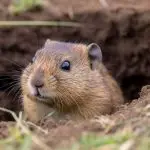Can You Drown A Gopher? Keeping Gophers Out Of Your Garden And Yard
Gophers can cause a lot of damage to lawns, gardens, and crops, making them a major nuisance for homeowners and gardeners alike. These small, burrowing rodents can create extensive tunnels and mounds of dirt. These damage roots and make maintaining a beautiful and healthy outdoor space difficult.
There are several different methods of gopher control, and they include:
- Trapping
- Using repellents
- Poisoning
Each method has pros and cons, and as a homeowner, you must consider cost, effectiveness, and potential risks before selecting a method.
However, one method that has gained popularity among some homeowners and gardeners is drowning. This controversial method involves flooding gopher tunnels with water, causing the rodents to drown.
While drowning may be an effective method of controlling gophers, it is essential to consider the efficacy and ethical implications of using this method. As a homeowner or gardener, you must weigh the potential benefits of drowning gophers against the risks of other wildlife removal and the environment.
Continue reading to learn everything you need to know whether you can drown a gopher, including its efficacy and ethical considerations.
The Efficacy Of Drowning As A Gopher Control Method
When it comes to gopher control, drowning is one method that is often considered. However, before deciding to use this method, it is crucial to consider its efficacy and its potential drawbacks.

Is Drowning An Effective Method Of Gopher Control?
Drowning is a pest control method that can be effective when used correctly. The basic idea behind drowning is to flood the gopher burrow system, forcing the gophers to the surface where they can be trapped or killed.
This method can be effective because gophers are excellent diggers who quickly burrow away from traps or other control measures. By flooding the burrow system, the gophers have nowhere to go and are forced to the surface.
However, it is essential to note that drowning may not be effective in all situations. For example, if the gophers have multiple burrow systems or if the soil is too dry, flooding may not be effective.
Additionally, gophers are known for their territorial behavior and aggression. If one gopher is removed from an area, another may move in to take its place.
How Does Drowning Work As A Pest Control Method?
Drowning is a gopher control method involving flooding the burrow system with water.
You can use different drowning methods for pest management. But the most common involves locating the main tunnel or run and placing a hose or pipe into the burrow. The hole is then sealed with dirt or a cap. Next, the water is pumped into the hole until the burrow system is flooded.

The amount of time it takes to drown a gopher depends on the size of the burrow system, the amount of water used, and other factors. Some gopher species can hold their breath for up to 5 minutes, so it may take some time for them to drown.
What Are The Potential Drawbacks Of Drowning?
While drowning can be an effective method of gopher control, it is essential to consider the potential drawbacks before deciding to use this method.
Need for specialized equipment.
Drowning requires a pump or other means of flooding the burrow system, which can be expensive to rent or purchase.
Possibility of injuring other animals or the environment.
Flooding the burrow system too quickly can cause the soil to become saturated and unstable, leading to erosion or other issues.
Other animals living in or near the burrow system, such as snakes or mice, may also be drowned or displaced. This can have a negative impact on the local ecosystem.
Therefore, before using drowning as a method of gopher control, it is important to weigh its potential efficacy against its potential drawbacks. Also, consider the alternatives: more humane gopher control methods.
The Ethics Of Drowning As A Gopher Control Method
The ethical considerations of using drowning as a gopher control method are complex. After all, there are two primary ethical considerations to consider, and they include the following.

1. Animal Welfare
Advocates of drowning argue that it is a humane way to kill gophers since it causes them to lose consciousness quickly and painlessly.
However, humane societies argue that it is inhumane since it causes the gophers to experience extreme anxiety and suffering before they lose consciousness. It can also affect animal behavior if they survive.
2. Impact On The Environment
Drowning traps, including pets and wildlife, can harm other animals that accidentally fall into them. In addition, the chemicals used to bait the traps can pollute the soil and groundwater.
These ethical considerations come into play mainly in advocating humane pest control methods. This concept is based on the idea that pest control methods should cause the least suffering to the targeted animals while minimizing harm to the environment and other animals.
This means that pest control methods should be both effective and humane. Drowning is not typically considered a humane pest control method since it can cause significant suffering to the gophers.
Alternative Humane Methods Of Gopher Control
More humane pest control methods involve capturing gophers and moving them to a new location where they can live without causing property damage. These humane methods of gopher control include:
- Live trapping: It is a popular alternative to drowning since it is more humane and does not involve killing the gophers. Live traps are designed to capture gophers alive and unharmed, making it possible to relocate them to a new location without causing harm.

Box traps are one of the most effective gopher trapping methods, designed to capture gophers without injuring them. These traps are placed in the gopher’s tunnel and triggered when the gopher enters the trap.
- The use of repellents: Repellents are chemicals or natural substances designed to repel gophers from an area without causing them harm. Repellents are an excellent option for those looking for a more humane and environmentally friendly way to control gophers.
- Exclusion: It involves using barriers to prevent gophers from entering the garden or lawn and habitat modification. Because gophers eat on roots and tubers, this prevents pests from burrowing into sensitive areas of your lawn or garden or pushing dirt to the surface.
Drowning Gophers: Step-by-Step Guide
If you decide that drowning is the most appropriate pest prevention method for your situation, there are a few steps you’ll need to follow. These steps will help you to do it effectively and humanely.

Before you start, you should ensure that you have the following materials with you:
- Garden shovel or trowel
- Large bucket or container
- Sturdy mesh screen or wire cage
- Water source
- A heavy object (e.g., brick, rock, or cinder block)
Now here is the step-by-step guide to drowning gophers:
Step 1: Locate Gopher Tunnels
The first step in drowning gophers is to locate their tunnels. Look for mounds of dirt that indicate where gophers have been burrowing. Carefully dig into the soil using a garden shovel or trowel until you reach the tunnel.
Step 2: Set Up the Drowning Trap
Once you have located the tunnel, place the large bucket or container over the hole. Use a deep container to allow the gopher to submerge and drown entirely.
Cover the top of the container with the sturdy mesh screen or wire cage, ensuring it is securely fastened. This will prevent the gopher from escaping or injuring itself while trying to escape.
Step 3: Flood the Tunnel
Next, use a hose or other water source to flood the tunnel. This will cause the gopher to become disoriented and attempt to escape through the nearest opening, leading to the container you have set up. Once the gopher falls into the container, it cannot escape due to the wire cage or mesh screen on top.
Step 4: Monitor the Trap
Monitoring the trap closely and removing any gophers as soon as possible is crucial to avoid unnecessary suffering. Once the gopher has drowned, remove the container from the tunnel and dispose of the animal per local regulations.
The Legal And Regulatory Landscape Of Drowning Gophers
The use of drowning as a pest control method for gophers is subject to various local and state trapping regulations. The legality of drowning gophers may vary depending on the jurisdiction. So, homeowners and gardeners must generally follow specific rules and regulations to avoid breaking any laws.
Before attempting to use drowning as a gopher control method, it is essential to research and understands the regulations in your area. Some states and localities may require a permit to use drowning traps, while others may prohibit it entirely.

For example, the state ruled that drowning gophers was a waste of water resources in California. Therefore, checking with your local wildlife or pest control companies is vital to ensure you comply with all applicable regulations.
In addition to regulations related to drowning traps, there may also be restrictions on the disposal of trapped gophers. Some jurisdictions require that trapped animals be released into the wild at a specific distance from residential areas. At the same time, others may require that they be euthanized.
If you’re interested in learning more about gophers and whether drowning is an effective method for controlling them, be sure to check out our article on whether you can drown a gopher. Additionally, if you’re looking for ways to keep gophers out of your raised beds, you might be interested in our article on how to keep gophers out of raised beds. Our piece on how much gopher removal costs provides information on the cost of hiring a professional for removal, while our article on how to keep gophers out of raised beds offers practical tips for preventing gophers from damaging your plants.FAQs
Here are a few related questions you might be asking about drowning gophers.
Q1: Is drowning a gopher legal?
The legality of drowning gophers varies depending on the jurisdiction. Checking with local authorities before using drowning as a pest control method is essential.
Q2: How long does it take for a gopher to drown?
It typically takes between five and ten minutes for a gopher to drown. After all, these backyard pests can hold their breath for a very long time.
Q3: Are there any risks to other animals or the environment when drowning gophers?
Yes, there can be risks to other animals and the environment when drowning gophers. If drowning occurs in a body of water, it can contaminate the water source. This can harm other animals that depend on the water source for survival, and it can also affect the quality of the environment.
In addition, drowning gophers can also disturb the soil and vegetation around their burrows, affecting other animals that rely on these habitats.
Conclusion
Gophers can be a nuisance in your yard or garden, and controlling them becomes necessary at a certain period. It’s essential to consider efficacy and ethics when selecting a pest control method.
While drowning can be an effective method of gopher control, it’s essential to be aware of the potential drawbacks. This includes the need for specialized trapping equipment and the risk of harming other animals.
It’s also important to consider the ethical implications of drowning as a gopher control method. Ensure you do further research to explore more ethical gopher control methods, such as live trapping and relocation.
At the same time, check local and state regulations regarding drowning as a pest control method. In some areas, it may not be legal or may require a permit.
Ethically, drowning gophers raises concerns about animal welfare and environmental impact. Humane pest control practices prioritize minimizing harm to animals and reducing ecological damage. Drowning gophers may not fit into this framework for some individuals.
Alternatives such as live trapping and relocation may be more humane solutions. By considering both efficacy and ethics, you can select a pest control method that is both effective and humane.




